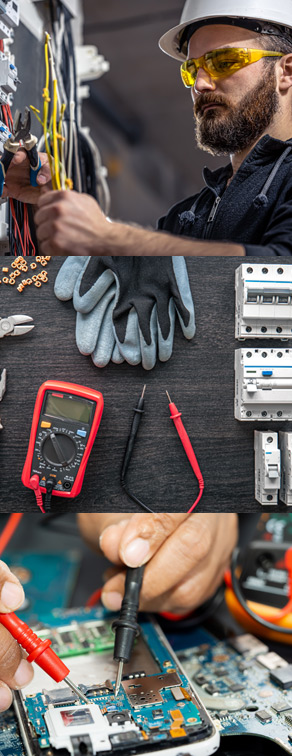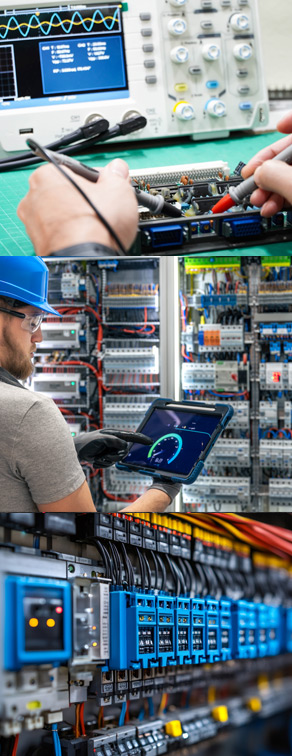About
At Rosemount Technology Centre, students in Electromechanics acquire the knowledge, skills and attitude required to ensure the operation and maintenance of automated production equipment; to take action at the primary operational level; to service different types of automated systems and their mechanical, hydraulic, pneumatic, electrical and electronic components; and to work in one of the various types of production industries that use automated systems.
Here are some of the things you will learn:


The Automated Systems in Electromechanics program leading to a DVS is a 1800 hour course.
Day program (6 hrs/day): approximately 18 months.
This program is taught mainly from two campuses:
Main Campus located at 3737 Beaubien Est AND Curtis George Campus located at 10909 Gariépy Street.
(One 3-week welding module is taught from the Des Grandes Prairies Campus located at 6065 Des Grandes Prairies).
| Program Competencies | Hours | Credits | |
|---|---|---|---|
| 1 | The Occupation and Training Process This module introduces the student to the automated systems electromechanics trade and its many interesting opportunities. While learning about which abilities and skills are required, course expectations, as well as working conditions and job prospects, the student reconfirms commitment to the program of study. |
15 | 1 |
| 2 | Health and Safety The student will learn how to identify hazards, prevent risks and eliminate dangers on construction and industrial maintenance sites. |
30 | 2 |
| 3 | Using Computers During this preliminary computer module, the student learns data management and research using a personal computer workstation, the local area network, as well as the Internet. Current application programs specific to the electromechanical trade are introduced. |
30 | 2 |
| 4 | Checking Electrical Circuits The student learns to safely and accurately measure, test and troubleshoot DC and AC circuits using oscilloscopes, A-meters as well as digital and analog instrumentation, on low and medium voltage equipment and machinery. |
120 | 8 |
| 5 | Drawing Sketches Using design standards and conventions, the student will draw orthogonal, isometric, and freehand sketches using both the imperial and metric systems of measurement. |
30 | 2 |
| 6 | Performing Manual Machining Operations The student produces a moderately-complex useful object out of plastics, ferrous, and non-ferrous metals using hand tools. The student will practice marking-out, filing, boring and tapping as well as measuring with micrometers and callipers. Students maintain quality and adhere to industry standards and tolerances. |
105 | 7 |
| 7 | Moving Equipment Safely moving, storing, disassembling and assembling materials and equipment is an integral part of the industry. The student learns appropriate selection and use of techniques for lifting and moving loads with levers, hoists, cranes, cables, and slings. Signalling codes and knowledge of knots enables the student to perform tasks from drawings and written instructions. |
30 | 2 |
| 8 | Cutting and Welding The student will learn electric arc, semi-automatic MIG and TIG welding techniques for corrective maintenance. He/she will cut and weld metal sheets while learning proper adjustment of welding equipment. Strict health and safety procedures for using, dismantling, and storing welding equipment are stressed. |
75 | 5 |
| 9 | Connecting Conduits By assembling an actual circuit, the student learns to install and maintain ferrous and non-ferrous pipes, hoses and conduits. He/she will measure, cut, bend, flare, solder, glue, and crimp pipes and conduits made out of copper, iron, and rubber. Quality is measured using leak-test techniques and tools. |
30 | 2 |
| 10 | Industrial Electronics Circuits Troubleshooting flow charts, detecting input and output (I/O) signal defects and the appropriate selection and replacement of defective components is the cornerstone of this module. The student learns to measure I/O signals using oscilloscopes, VOM-meters, and signal generators on pre-wired electronic boards. |
105 | 7 |
| 11 | Using Machine Tools Using our extensive machine shop, the student will learn to machine moderately complex parts using lathes, milling and grinding machines, etc. Emphasis is placed on safety as well as precise, methodical work which uses materials economically. |
90 | 6 |
| 12 | Analyzing Logic Circuits The core of the automated system is the sequential operations of the logic circuit using electric, electronic, pneumatic and hydraulic solutions. The student will analyze and troubleshoot real logic circuits and solve combinational and sequential logic equations with respect to I/O variables. |
90 | 6 |
| 13 | Conventional Alignment The student will perform vertical and horizontal alignment tests for shafts, belts, and pulleys using gauges, laser devices, and other alignment equipment on a real automated system. |
30 | 2 |
| 14 | Maintaining Mechanical Devices Conduct preventative and corrective maintenance on motion-transmission mechanical devices, such as shafts, bushings, bearings, pulleys, and belts. While using logical sequencing to assemble and disassemble gear boxes, bearings, drives, and other motion-transmission components, emphasis will be placed on the student acquiring a solid understanding of wear, friction, and industrial lubrication. |
105 | 7 |
| 15 | Assembling Pneumatic Circuits The student will learn to design, prototype, produce, and troubleshoot an industrial pneumatic circuit. Simulation software is used to size pneumatic components, simulate faults, and debug activities. |
75 | 5 |
| 16 | Assembling Hydraulic Circuits The student will learn to design, produce and troubleshoot a functional hydraulic circuit operating up to 1000 psi, using an assembly panel, hydraulic instrumentation and hydraulic power packs. |
60 | 4 |
| 17 | Maintaining Motor Circuits Learn to operate high voltage AC and DC motors, including control of starting, breaking, torque, and speed. The student will schedule and perform preventive and corrective maintenance. |
105 | 7 |
| 18 | Maintaining Pneumatic and Hydraulic Equipment Perform preventive and corrective maintenance on hydraulic pumps, air compressors, and motors. The student will acquire a thorough knowledge of lubrication, oils and their problems, cleaning methods, as well as the alignment and adjustment of hydraulic and pneumatic components. |
60 | 4 |
| 19 | Calibrating a Control Loop The student will learn to calibrate and adjust the parameters of an industrial control loop. Student will use a process control simulator to adjust level, pressure, flow and temperature in open and closed loop circuits. |
60 | 4 |
| 20 | Maintaining Electropneumatic & Electrohydraulic Circuits Maintaining Electropneumatic & Maintaining electropneumatic and electrohydraulic circuits includes adjustment and control of pressure and flow, and the inspection of electrical connections and safety devices in concordance with the Canadian Electrical Code. The student will perform quality control, verification, testing and troubleshooting of electropneumatic and electrohydraulic circuits. |
60 | 4 |
| 21 | Programming Controllers The student will learn the basic languages for programming Programmable Logic Controllers (PLCs). He/she will gain experience using several different communication protocols, such as, Device net, Modbus, Ethernet, etc., as well as different network platforms and user interfaces. Students will learn and apply configurations for communication between controllers and interfaces, defining the run and off modes of automated systems. |
90 | 6 |
| 22 | Electric Motor Control Devices From the connection of AC and DC drives to their corresponding motors to the programming of the drives, student will learn to configure, activate, assess feedback, and service electric motor control devices. Either as a stand alone system or within a network, the student will learn to monitor and modify the electronic components. |
60 | 4 |
| 23 | Job Search Techniques Developing strategies and techniques for finding a job are critical components of the training program. The student will prepare a cover letter and a resumé and learn to prepare for employment interviews. Guest speakers will bring practical advice and hints on getting that first job. |
15 | 1 |
| 24 | Installing an Automated System Working in a team, the student will do the complete installation of a functioning automated system, from the connection of the electrical and mechanical equipment to the configuration and installation of the hardware and software. |
105 | 7 |
| 25 | Planned Maintenance Proactive preventive maintenance concepts will be reinforced while the student implements a virtual maintenance schedule using specialized software (PM) for an operating automated system. Drawing from concepts learned in previous modules, the student will apply risk management and failure theory to the every day life of an electromechanical system. |
45 | 3 |
| 26 | Troubleshooting Automated Systems In this module the student faces the ultimate challenge and reward of the program. In an automated system where defects have been intentionally lodged, the student must identify the root causes and then find solutions to the problems. |
90 | 6 |
| 27 | Entering the Work Force For three to four weeks the student will do a stage at a company with an automated electromechanical system. He/she will apply his/her knowledge while working to gain experience and understanding of working under “real world” conditions. |
90 | 6 |
| Total |
1800 | 120 |
Photo-Electronic Regulator Repairer
Electronic Equipment Repairer
Automated Systems Repairer
Automated Processing Equipment Repairer
Control Panel Tester
Maintenance of Automated and Manual Machines
To be eligible for admission to this program, candidates must meet one of the following requirements:
Persons holding a Secondary School Diploma or its recognized equivalent, for example, an Attestation of Equivalence of Secondary V studies, or a postsecondary diploma such as the Diploma of College Studies or a Bachelor's degree
OR
Persons who are at least 16 years of age on September 30 of the school year in which their training is to begin and have earned the Secondary IV credits in language of instruction, second language and mathematics in the programs of study established by the Minister, or have been granted recognition for equivalent learning
OR
Persons who are at least 18 years of age upon entry into the program and have the following functional prerequisites: the successful completion of the General Development Test (see the following table), or recognition of equivalent learning
OR
Persons who have obtained Secondary III credits in language of instruction, second language and mathematics in programs established by the Minister are required to pursue general education courses, concurrently with their vocational training, in order to obtain the Secondary IV credits they lack in language of instruction, second language and mathematics in programs established by the Minister.
This section identifies the modules or course codes for the actual programs of study in adult general education that are specific prerequisites in language of instruction and mathematics. Functional prerequisites includes the successful completion of specific prerequisites as well as the general development test (TDG). When a DVS doesn't require specific prerequisites in language of instruction or in mathematics, a dash ( - ) is displayed in the appropriate cell. For programs that lead to an AVS, specific prerequisites and the TDG do not apply (N/A).
| Language of instruction | |||
|---|---|---|---|
| Adults ENG-3103-3 ou (ENG-3071-3) |
|||
| Youth 632-406 ou (630-416) |
|||
Mathematics |
|||
| Adults MTH-3053-2 ou (MTH-3016-2) |
|||
| Youth 563-306 ou (568-314) |
Send an email to aevsinternational@emsb.qc.ca with the following information:
Begin the following steps to insure a complete student dossier
Here is a collection of digital artwork that has been created by students in our Computer Graphics program using Adobe Illustrator, Photoshop, InDesign and Dreamweaver. It is a small sampling of artwork for those who are interested in learning more about computer graphics, or those who want to gain inspiration for their own digital artwork, or for those who simply want to see what others have created.
ROSEMOUNT TECHNOLOGY CENTRE
Copyright ©2005-2025 Rosemount Technology Centre. All Right Reserved.